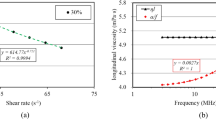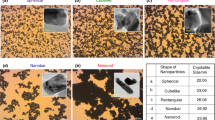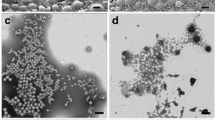Abstract
In this paper, ultrasonic attenuation and electroacoustic techniques are proposed to study the dispersion behaviors and properties of binary particles in high-concentration suspension, to provide an effective characterization method for the design, preparation, and application of complex suspensions with nano- and microparticles. Both suspensions with binary and identical particles were prepared, with submicron cerium oxide (CeO2) particles and micron carbonyl iron powder (CIP) particles, respectively. The particle size distribution (PSD) in suspensions with binary particles was analyzed based on ultrasonic attenuation spectra with different models, and their zeta potential was analyzed based on electroacoustic measurements with different models too. The results showed that the zeta potential signs of CeO2 and CIP particles in suspensions with identical particles were opposite, and the pH value, zeta potential, and dispersion state of CeO2 and CIP particles changed significantly after mixing. The PSD and zeta potential of the binary particles obtained from the effective medium model had large deviations. The binary phase model can obtain accurate zeta potential of binary particles in suspensions, but it obtained PSD of binary particles with some deviation due to agglomeration. The equivalent volume model was brought forward to analyze the actual state of these particles with small density contrast. In these suspensions, the binary particles could be dispersed more efficiently than those in suspensions with identical particles, although there still did exist some agglomerates in the binary suspensions. These results provide a new technique and method for studying the behavior and properties of binary particles in high-concentration complex suspensions.
Graphical abstract









Similar content being viewed by others
References
Grubenmann A, Mollet H (2008) Formulation technology: emulsions, suspensions, solid forms. John Wiley & Sons New, Hoboken
Bielmann M (1999) Effect of particle size during tungsten chemical mechanical polishing. Electrochem Solid-State Lett 2(8):401–403. https://doi.org/10.1149/1.1390851
Jolly MR, Bender JW, Carlson JD (1999) Properties and applications of commercial magnetorheological fluids. J Intell Mater Syst Struct 10(1):5–13. https://doi.org/10.1106/R9AJ-XYT5-FG0J-23G1
Dukhin AS, Goetz PJ (1998) Characterization of aggregation phenomena by means of acoustic and electroacoustic spectroscopy. Colloids Surf A 144(1–3):49–58. https://doi.org/10.1016/S0927-7757(98)00565-2
Dukhin AS, Goetz PJ (2001) Acoustic and electroacoustic spectroscopy for characterizing concentrated dispersions and emulsions. Adv Coll Interface Sci 92(1–3):73–132. https://doi.org/10.1016/S0001-8686(00)00035-X
Tüzün U, Farhadpour FA (1986) Dynamic particle size analysis with light scattering technique. Part Part Syst Charact 3(4):151–157. https://doi.org/10.1002/ppsc.19860030403
Dukhin AS, Goetz PJ (2001) New developments in acoustic and electroacoustic spectroscopy for characterizing concentrated dispersions. Colloids Surf, A 192(1–3):267–306. https://doi.org/10.1016/S0927-7757(01)00730-0
Dukhin AS, Goetz PJ (2000) Characterization of concentrated dispersions with several dispersed phases by means of acoustic spectroscopy. Langmuir 16(20):7597–7604. https://doi.org/10.1021/la991600i
Dukhin AS, Goetz PJ, Hackley V (1998) Modified log-normal particle size distribution in acoustic spectroscopy. Colloids Surf, A 138(1):1–9. https://doi.org/10.1016/S0927-7757(97)00011-3
Hunter RJ (2013) Zeta potential in colloid science: principles and applications. Academic press, San Diego
Croll S (2002) DLVO theory applied to TiO2 pigments and other materials in latex paints. Prog Org Coat 44(2):131–146. https://doi.org/10.1016/S0300-9440(01)00261-2
Williams D, Williams KP (1978) Electrophoresis and zeta potential of kaolinite. J Colloid Interface Sci 65(1):79–87. https://doi.org/10.1016/0021-9797(78)90260-6
Greenwood R (2003) Review of the measurement of zeta potentials in concentrated aqueous suspensions using electroacoustics. Adv Coll Interface Sci 106(1–3):55–81. https://doi.org/10.1016/S0001-8686(03)00105-2
Greenwood R, Lapčíková B, Surynek M et al (2007) The zeta potential of kaolin suspensions measured by electrophoresis and electroacoustics. Chem Pap 61(2):83–92. https://doi.org/10.2478/s11696-007-0003-x
Dukhin AS, Ohshima H, Shilov VN et al (1999) Electroacoustics for concentrated dispersions. Langmuir 15(10):3445–3451. https://doi.org/10.1021/la9813836
Dukhin AS, Goetz PJ, Wines TH et al (2000) Acoustic and electroacoustic spectroscopy. Colloids Surf A 173(1–3):127–158. https://doi.org/10.1016/S0927-7757(00)00593-8
Grasso D, Subramaniam K, Butkus M et al (2002) A review of non-DLVO interactions in environmental colloidal systems. Rev Environ Sci Biotechnol 1(1):17–38. https://doi.org/10.1023/A:1015146710500
Dobnikar J, Chen Y, Rzehak R et al (2002) Many-body interactions in colloidal suspensions. J Phys: Condens Matter 15(1):S263. https://doi.org/10.1088/0953-8984/15/1/335
Taurozzi JS, Hackley VA, Wiesner MR (2011) Ultrasonic dispersion of nanoparticles for environmental, health and safety assessment-issues and recommendations. Nanotoxicology 5(4):711–729. https://doi.org/10.3109/17435390.2010.528846
Bansal P, Deshpande AP, Basavaraj MG (2017) Hetero-aggregation of oppositely charged nanoparticles. J Colloid Interface Sci 492:92–100. https://doi.org/10.1016/j.jcis.2016.12.059
Trefalt G, Behrens SH, Borkovec M (2016) Charge regulation in the electrical double layer: ion adsorption and surface interactions. Langmuir 32(2):380–400. https://doi.org/10.1021/acs.langmuir.5b03611
Russel WB (1981) Brownian motion of small particles suspended in liquids. Annu Rev Fluid Mech 13(1):425–455. https://doi.org/10.1146/annurev.fl.13.010181.002233
Acknowledgements
Financial support for this research work was provided by the National Natural Science Foundation of China (grant no. 51905506) and the Institute of Machinery Manufacturing Technology, China Academy of Engineering Physics.
Author information
Authors and Affiliations
Corresponding author
Ethics declarations
Conflict of interest
The authors declare that they have no conflict of interest.
Additional information
Publisher's note
Springer Nature remains neutral with regard to jurisdictional claims in published maps and institutional affiliations.
Highlights
• The effective medium model does not work well for binary particles with opposite sign of zeta potential.
• The binary phase model can analyze the zeta potential of the binary particles while it obtains biased PSD results.
• The equivalent volume model can analyze the PSD of the binary particles with small-density contrast.
Rights and permissions
Springer Nature or its licensor holds exclusive rights to this article under a publishing agreement with the author(s) or other rightsholder(s); author self-archiving of the accepted manuscript version of this article is solely governed by the terms of such publishing agreement and applicable law.
About this article
Cite this article
Luo, Z., Wei, Q., Yang, Q. et al. Study on the dispersion behaviors of binary micro/nanoparticles in concentrated suspensions by ultrasonic attenuation technology. J Nanopart Res 24, 182 (2022). https://doi.org/10.1007/s11051-022-05567-4
Received:
Accepted:
Published:
DOI: https://doi.org/10.1007/s11051-022-05567-4




